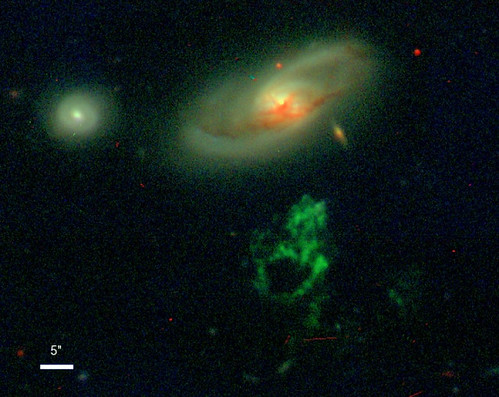The Mystery of Hanny’s Voorwerp
- By Koji Mukai
- December 10, 2010
- 1 Comment
Astronomical headlines are often written about an object that was observed recently. It could be about the brightest stellar flare ever seen, the most recently formed black hole, or a newly discovered eclipsing pulsar that allows a strict test of general relativity. But a few headlines are about the “dog that didn’t bark”, so to speak. This is a blog about one such headline.
You could compare this headline to the one that was on the sports section of newspapers all across the US on the morning of Monday, September 21, 1998. It wasn’t about an NFL quarterback who threw 4 touchdowns, it wasn’t about a multi home-run game by a baseball slugger or pennant clinching win by his team, and it wasn’t about a pre-season blockbuster trade in the NBA. It was about an athlete who didn’t play the previous day.
Back to astronomy. Dr. Kevin Schawinski of Yale and his collaborators published a paper with the title “the sudden death of the nearest quasar” in the 2010 November 20 issue of Astrophysical Journal Letters. This concerns a galaxy named IC 2497 and a cloud of ionized gas 45,000 to 70,000 light years away from it known as Hanny’s Voorwerp (Dutch for “Hanny’s Object”). The Voorwerp is a fascinating object in two ways. For one thing, there was no obvious explanation of why this cloud was so ionized. For another, it was actually discovered in 2007 by an amateur Galaxy Zoo project volunteer, Hanny van Arkel, a Dutch school teacher. (There’s even a comic book about the Voorwerp!)

Ground-based optical image of IC 2497 (top), Hanny’s Voorwerp (bottom), and a nearby
companion galaxy (left). This image is a composite of blue, visual, and near infrared light
images taken with the WIYN telescope. Credit: WIYN/William Keel/Anna Manning
Before Dr. Schawinski’s 2010 paper came out, the mystery was this: IC 2497 must be a powerful quasar to be able to explain how ionized the Voorwerp is, but IC 2497 didn’t look like a quasar. Observations with radio telescopes on the ground and the Hubble Space Telescope show that there is a weak nuclear activity in this galaxy, but far too faint to qualify the galaxy as a quasar, or to explain the Voorwerp.
One idea was that there is a powerful quasar in IC 2497, but it’s hidden by an obscuring cloud of gas and dust. Dr. Schawinski’s team tested this using infrared and X-ray observations. If there is an obscuring dust cloud, it should be heated up by the quasar and give off a warm glow in the infrared. No sign of this was seen. Even if there is an obscuring cloud, X-rays with energies above 10 keV, which are hard to absorb (and so are called “hard X-rays”), should shine through. However, even using the Suzaku satellite which is very sensitive to hard X-rays, no quasar was detected.
With this lack of hard X-ray detection, Dr. Schawinski and colleagues have concluded that there is only one viable explanation for the Voorwerp: there was a powerful quasar in IC 2497 as recently as 70,000 years ago (plus the light travel time from IC 2497 to us). The quasar has shut off since then, however, so we cannot detect it directly when we observe IC 2497. Only the indirect glow that is Hanny’s Voorwerp tells us that there was a quasar in the recent past. This time scale is not too short to be crazy, but short enough to be interesting to people who study how supermassive black holes find fuels to become a quasar – and then turn off.
Oh, and the sports page headline? Cal Ripken Jr. of baseball’s Baltimore Orioles voluntarily sat out a game on September 20th, 1998, ending his streak of 2,632 consecutive games played. Like the Iron Man of baseball, the supermassive black hole in IC 2497 made the news by stopping what it used to do, in a rare case of astronomical headline about a non-detection.
If you’d like to read more about Hanny’s Voorwerp, and this discovery, here are some links:



This is a great blip about quasars- it provided me with some solid leads for a paper I’m preparing at school. Thank You!